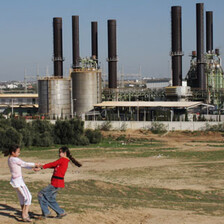The Electronic Intifada 9 February 2010
RAMALLAH, occupied West Bank (IPS) - Pressure exerted on the Palestinian Authority (PA) by international and regional officials has given Gazans a last minute reprieve, albeit temporary, from plunging into darkness and plummeting temperatures.
“The emergency has been temporarily halted after the PA released urgent funds to finance two fuel tankers entering Gaza on Sunday,” says Osama Dabou from Gaza’s Power Plant (GPP) authority.
“We are expecting several other fuel tankers to enter Gaza shortly. But this is only an interim stop-gap and will only last a short while after which the situation will again reach a critical point,” Dabou told IPS.
“If the fuel runs out we are talking about Gaza’s essential services which are reliant on electricity grinding to a halt. These include hospitals, health centers, and waste water plants,” Jamal Hamad, a spokesman from Gaza’s UN agency for Palestine refugees (UNRWA) told IPS.
Telecommunications would also be adversely affected.
On Saturday Gaza’s Energy Authority (GEA) released an urgent appeal announcing that its only power plant had shut down one of two generators which had been operational.
The statement added that the remaining generator had only enough fuel to operate until Sunday morning and was operating at a reduced capacity of only 30 megawatts.
“Gaza will suffer as a result. The plant is currently unable to provide power for over 50 percent of residents and this will rise to 60 percent if the bad weather continues,” said the GEA. A late winter cold front sent temperatures plummeting to below average several days ago.
“We had no electricity on Sunday until 11pm. Again on Monday at 6am when I woke up there was no electricity,” Hamada told IPS.
“We have been having rolling electricity blackouts for years now. The last few months have been serious and the last week dire,” he added.
Israel’s embargo on the coastal territory has drastically cut the amount of electricity provided by an Israeli electricity grid. Imports of Israeli industrial fuel, on which Gaza power plant’s generators are dependent, has also been severely restricted.
Furthermore, Gaza’s electricity grid, which was severely damaged by Israeli bombing during the war, is not fully functional with Israel preventing most vital spare parts from entering the strip.
Due to the fuel shortages Gazans have been forced to rely on lower quality fuel smuggled through underground tunnels from Egypt.
However, the power produced by home generators is too weak to be used for heating and can only generally be used for limited periods of cooking and recharging mobile phones.
Gaza’s energy crisis reached a peak this January after the European Union (EU) stopped paying for fuel shipments to the Palestinian territory.
Its contract to do so expired at the end of last November. The EU has demanded that the PA in Ramallah draft a new agreement and payment scheme.
This follows an EU decision that PEGASE, the EU’s monitoring mechanism, would help the PA implement a three-year Palestinian Reform and Development Plan (PRDP), approved by the World Bank and the International Monetary Fund.
Under the PRDP plan the PA is obliged to finance annual deficits and implement an investment program.
In January the PA stepped in to bridge the gap left by the EU but it reduced funds allocated for Gaza’s fuel saying it had budgetary restrictions and more important priorities such as the payment of civil servants wages in the PA controlled West Bank.
The GEA responded by asking the international community, the Arab countries and members of the Organization of Islamic Conference (OIC) to hold the PA responsible for the developing humanitarian crisis.
The GEA also accused the PA’s ministry of finance of adding tax surcharges on its January fuel payment, reducing its payment from approximately $9 million to $3.5 million.
GEA claimed this was more than 50 percent of the cost of diesel. The PA denied the accusations.
While the pending disaster has been temporarily averted the UN Office for the Coordination of Humanitarian Affairs (OCHA) reported in January that fuel imports in December had already decreased by 10 percent from the previous month and represented only 63 percent of needs.
“According to the Gaza Power Plant (GPP) authority, the amount entered represents 63 percent of the estimated monthly needs.”
“According to the Gaza Electricity Distribution Company (GEDCO), 95 percent of the Gaza population still experiences intermittent power supply, with scheduled outages ranging between six and eight hours per day, 3-4 days a week,” reported OCHA.
Meanwhile, Gaza’s Coastal Municipalities Water Utility (CMWU) has not received a single truckload of urgent equipment such as generators and drainage pumps for reconstruction and repairs to its water wells. Power shortages stop the water flow heightening the risk of water being contaminated.
“Gaza’s fuel crisis is limping along from day to day. The danger of Gaza running out of fuel for more than a few days is always there and in this case the situation could become life threatening,” Karl Schembri from Oxfam’s Gaza office told IPS.
“The latest development is only compounding an already serious situation.”
All rights reserved, IPS — Inter Press Service (2010). Total or partial publication, retransmission or sale forbidden.




